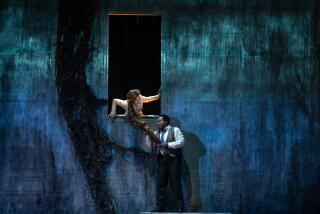Debussy Meets His Match in Aldo Ciccolini Showcase
- Share via
Aldo Ciccolini comes by his Debussyan credentials honestly. A specialist in the elusive French master’s works since the earliest days of his career in his native Italy--and for more than 40 years in his adoptive homeland, France--Ciccolini has been passing on his knowledge and affection for the composer to students at the Paris Conservatoire for a quarter of a century.
Curiously, Debussy has not played a major part in Ciccolini’s recorded repertory--surely EMI’s decision rather than his. And though assigning the entire oeuvre (Debussy’s or, for that matter, Beethoven’s or Chopin’s) to a single performer is questionable practice, few artists remain identified as does Ciccolini with a body of music that in the grand old days of the solo recital was part of every pianist’s repertory and every listener’s experience.
Sampled on five individual EMI CDs (54447-54451), Ciccolini’s playing is never less than committed or accomplished. It is not of the old “tonal wash” (created by playing with the pedal half-raised throughout), its most celebrated exponent being Walter Gieseking. But if Ciccolini’s playing does not have the cool allure of a Gieseking (whose superb traversal of the two books of “Preludes” is on a single mid-priced CD, EMI 61004), it does display the virtues of linear strength and clarity without the demystifying percussiveness favored by some contemporary executants.
For a sampling of Ciccolini’s way with a varied range of the composer’s inspirations, try Volume I (54447): the two canonic sets of “Images” (1905, 1907), a third set, dating from 1894 but only recently come to light, as well as the slightly earlier “Estampes,” in which Debussy’s mistily evocative keyboard style reaches its first great peak, and some brief, beguiling salon pieces.
The Piano Trio in G, also recently discovered, dates from 1880, when the 18-year-old Debussy served as house pianist for Nadezhda von Meck, best known as Tchaikovsky’s patroness. The Trio gives some indication of where Debussy was, creatively, before becoming his recognizable self.
The clearest influences are those of Franck, in the opening movement of the 25-minute-long piece, and, less predictably, of Schumann in the finale. These also happen to be the work’s most fully formed sections.
In the first movement, Debussy already shows himself too independent simply to swipe Franck’s lazily sinuous chromatic style. Debussy adds rhythmic energy and an inkling of his own, not-quite-developed melodic notions. And the finale is particularly lively, with a whiff of the lyric melancholy familiar from Schumann’s solo piano music.
On its own, the Trio might not justify buying a top-priced CD, but the two (count ‘em) new versions of this rarity are offered within the context of imposing, well-executed and generous programs.
The Borodin Trio plays the Debussy big and lush, as it does (perhaps less appropriately) the Trio, Opus 35, by Joaquin Turina, a darkly attractive union of Baroque form and Spanish-Romantic melody, and the “Trio on Irish Folk Tunes” (1925), a craggily polyrhythmic, unsentimental (don’t expect familiar tunes) creation by the undervalued Swiss composer Frank Martin (Chandos 9016).
Debussy’s Trio betrays its immaturity more readily in the less effusive interpretation of Trio Fontenay (Teldec 44937), where it serves as a prelude to the Ravel Trio, in an exciting, rhythm-oriented (rather than Romantic) performance, and Faure’s rather aloof Opus 120 Trio, vitalized by these players’ structural grasp and technical security.
Admirers of conductor Ernest Ansermet and his lucid, realistically recorded (digital technology seems to take us further from orchestral reality every day) Debussy interpretations will be cheered by their reappearance, superbly remastered, in London’s mid-priced Jubilee series.
Those who did not grow up during the early stereo era, when Ansermet’s recordings proliferated, may find it difficult to cotton to his willing but not always able Orchestre de la Suisse Romande, whose unreliable woodwind into-nation was a given. For the rest of us, much of magic remains.
The most familiar works--”Prelude a l’Apres-midi d’un faune,” “La Mer,” the orchestral “Images” and “Nocturnes”--are here on three separate discs (433 712, 433 713, 433 714) along with the bewitching and increasingly popular “Jeux” and such relative rarities as “La Boite a joujoux,” the Clarinet Rhapsody, the early, almost Wagnerian “Printemps” and the exquisitely tender “Petite Suite.”
More to Read
The biggest entertainment stories
Get our big stories about Hollywood, film, television, music, arts, culture and more right in your inbox as soon as they publish.
You may occasionally receive promotional content from the Los Angeles Times.










